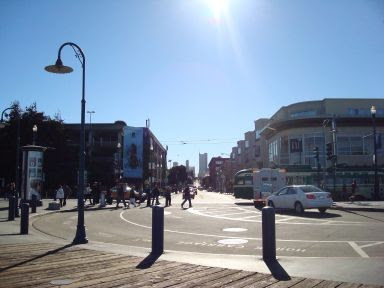Wednesday, March 5, 2008
JJ and SN
This is a picture of downtown San Francisco I took when I went to the Bay Area last year. I love San Francisco because, in my opinion, it's not uniform. It's culturally diverse, but it makes me feel cozy when I go downt here because the houses are small, yet it gives me a warm feeling of joy and joyness. I think the context of this photo would pertain to Jacob's [emotional] reaction to the "innovated" North End in Boston. The prominent feature of the housing in SF is the [not overdone] Venetian touch. Jacobs mentions Venetian effects on the "renovated" North End in 1959. She also states, " The streets were alive with children playing, people shopping,people strolling, people taking." This description is also valid with SF,where the streets of downtown are always animated and crowded with people-but not in a claustrophobic manner- but in a unifying exciting feel. Jacobs states, "This ubiquitous principle is the need of cities for mostintricate and close-gained diversity of uses that give each other constantmutual support, both economically and socially." I can take this text from Jacobs and apply it to the San Francisco city. The thing that stands outmost to me about SF, is that the mutual relationship among the communityis not forced, but instead, it is a rather natural occurrence. Even though SF is really busy, I believe that it contains elements that fit Jacobs' criteria.
Subscribe to:
Post Comments (Atom)

4 comments:
This image totally reminds me of when JJ saw the north end again in 1959. It looks rejuvenated, and full of life. Buildings looks as if they have been treated with lots of good 'ol TLC. More importantly, is the social performance going on -- the "sidewalk ballet." To quote, " The streets were alive with children playing, people shopping, people strolling, people talking." This description resembles the one shown in the picture, which is justh SOOO totally cool.
<3
Jane Jacobs would had liked this city. It has diversity and sidewalks. The people can keep their "eyes to the street". Sidewalks surround the this part of the city. The buildings seem like they were once traditional, then made modern as they were remodeled. There are people in the corner of the image. This seems to imply street culture.
This image, I think, really ties into the idea that the sidewalk is what links strangers together. It's the "vital part" of the city that is necessary for day to day life and activities. Jacobs abides by the idea of the "sidewalk ballet" which can be perceived from this image. A group of people who probably never met and will never meet each other are walking along the sidewalk to reach their individual destinations. It's a "complex order" because so many things happen on one sidewalk. I know when I went to San Fransisco, on one sidewalk alone you could find vendors, beggars, kids, strollers, people eating ice cream, people waiting for a ride, people bicycling and many more activities based on the street culture itself. It's a cool picture.
Jane Jacobs would have likes this portion of San Francisco because of the constant social interactions among diverse groups of people. The street in the background is a primarily example of these interactions, which Jacobs deems as the "sidewalk ballet". The street is always filled with different kinds of people. In the weekday mornings, workers from other districts and out of the city, would commute to San Francisco using MUNI or cars. In the afternoon, there will be shoppers, tourists, or just random people hanging around the streets. Almost everyone on the streets will be strangers and people that one would never see again.
Post a Comment